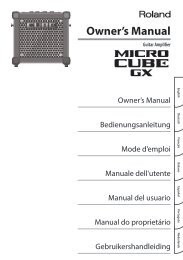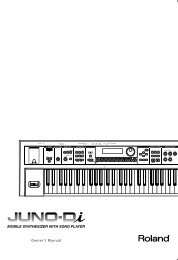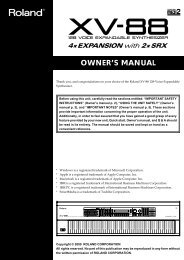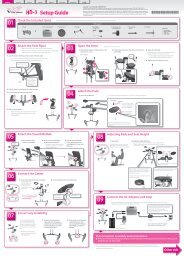Create successful ePaper yourself
Turn your PDF publications into a flip-book with our unique Google optimized e-Paper software.
Chapter 6. Creating an Original Pattern<br />
Changing the strength of the<br />
notes (Change Velocity)<br />
fig.PTNCVL<br />
This operation changes the velocity (strength) of the notes<br />
recorded in the pattern. Higher settings will cause the notes<br />
to be played more strongly. Use this when you want to make<br />
the notes stronger or weaker.<br />
Display Explanation Setting<br />
Specify the amount of the<br />
change in velocity.<br />
-99–0–99<br />
Press the part button [R] or [1]–[7] of the part whose velocity<br />
you wish to change, getting its indicator to light.<br />
* If this operation would result in a velocity greater than 127 (or<br />
less than 1), that velocity will be converted to 127 (or 1).<br />
Changing the note length<br />
(Change Gate Time)<br />
fig.CGT<br />
This operation changes the gate time (duration that the note<br />
is held) of the notes recorded in the pattern. Use this when<br />
you want to make the entire performance more staccato or<br />
tenuto.<br />
Display Explanation Setting<br />
Specify the amount of<br />
change in gate time.<br />
-99–0–99<br />
Press the part button [R] or [1]–[7] of the part whose gate<br />
time you wish to change, getting its indicator to light.<br />
Make fine adjustments in timing<br />
(Shift Clock)<br />
fig.PTNSCK<br />
Using this operation, the timing of the performance data<br />
recorded in the pattern can be shifted forward or backward<br />
in units of one clock (1/96th of a beat). Use this when you<br />
wish to move the entire performance slightly forward or<br />
backward.<br />
Display Explanation Setting<br />
Specify the shift<br />
clock amount.<br />
-99–0–99<br />
Press the part button [R] or [1]–[7] of the part whose timing<br />
you wish to change, getting its indicator to light.<br />
68<br />
Thinning out unnecessary data<br />
(Data Thin)<br />
fig.PTNDTH<br />
Since data such as Pitch Bend and Control Change typically<br />
has a continuously changing value, it can occupy an<br />
unexpectedly large amount of memory. The Data Thin<br />
operation thins out such data to reduce the amount of the<br />
data without affecting the audible result. This lets you make<br />
more efficient use of internal memory.<br />
Display Explanation Setting<br />
Specify the amount by<br />
which the data will be<br />
thinned.<br />
0–99<br />
Press the part button [R] or [1]–[7] of the part whose data you<br />
wish to thin, getting its indicator to light.<br />
Creating a quantized pattern<br />
(Edit Quantize)<br />
fig.PTNQTE<br />
This operation modifies the actual performance data of the<br />
pattern so it is aligned with the timing produced by the<br />
Quantize operation (p. 37).<br />
The normal Quantize operation does not modify the contents<br />
of the performance data; it merely adjusts the timing at<br />
which the pattern data is played back. Through the use of<br />
Edit Quantize, you can create data that incorporates the<br />
result of quantization.<br />
Display Explanation<br />
Apply the quantization settings.<br />
* You must first set Quantize (p. 37) to<br />
either GRID, SHUFFLE, or<br />
GROOVE. (If one of these are not<br />
selected, the data will not be modified.)<br />
Edit Quantize will be performed with<br />
this setting.<br />
Press the part button [R] or [1]–[7] of the part that you wish<br />
to quantize, getting its indicator to light.<br />
Saving a pattern<br />
When you have created a pattern that you like, you should<br />
save that pattern as a user pattern.<br />
For details on saving, refer to p. 20.<br />
If you edit another pattern, switch to Song mode, or turn off<br />
the power without saving the pattern you recorded or edited,<br />
your edits will be lost.

















